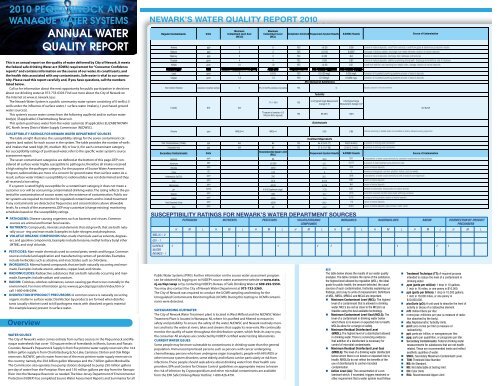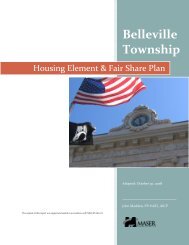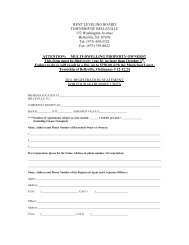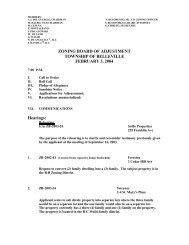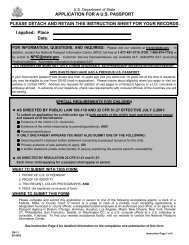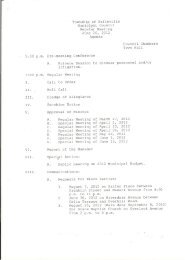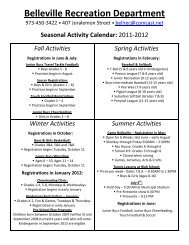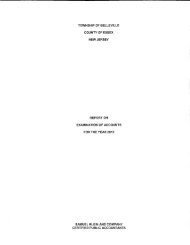2011-2012 Recycling Schedule Calendar - Belleville, NJ
2011-2012 Recycling Schedule Calendar - Belleville, NJ
2011-2012 Recycling Schedule Calendar - Belleville, NJ
You also want an ePaper? Increase the reach of your titles
YUMPU automatically turns print PDFs into web optimized ePapers that Google loves.
PATHOGENS NUTRIENTS PESTICIDES VOLATILE ORGANIC<br />
COMPOUNDS<br />
INORGANICS RADIONUCLIDES RADON DISENFECTION BY-PRODUCT<br />
PRECURSERS<br />
H M L H M L H M L H M L H M L H M L H M L H M L<br />
WELLS = 0<br />
GUI - 1<br />
SURFACE<br />
WATER<br />
INTAKES - 1<br />
1 1 1 1 1 1 1 1<br />
������������������������������������������������������������<br />
newark’s water quality report 2010<br />
KEY:<br />
The ta<br />
analys<br />
the hig<br />
goals<br />
source<br />
finding<br />
of MC<br />
��M<br />
le<br />
w<br />
f<br />
��M<br />
le<br />
w<br />
M<br />
��M<br />
(<br />
in<br />
t<br />
c<br />
��M<br />
(<br />
b<br />
h<br />
u<br />
c<br />
��A<br />
t<br />
o<br />
��T<br />
in<br />
d<br />
��p<br />
1<br />
��p<br />
1<br />
$<br />
��p<br />
a<br />
��m<br />
��m<br />
t<br />
��n<br />
��p<br />
r<br />
��p<br />
��p<br />
��S<br />
m<br />
r<br />
a<br />
��S<br />
��T<br />
��N<br />
��N<br />
��C<br />
��R<br />
WATER SOURCE<br />
The City of Newark’s water comes entirely from surface sources in the Pequannock and Wa-<br />
naque watersheds that cover 150 square miles of forestlands in Morris, Sussex and Passaic<br />
Counties. Newark’s Pequannock Supply is from five pristine water supply reservoirs; the 14.4<br />
billion gallon supply is from Charlottesburg, Echo Lake, Canistear, Clinton and Oak Ridge<br />
reservoirs. <strong>NJ</strong>DWSC gets its water from two of the most pristine water supply reservoirs in<br />
the country; namely, the 29.6 billion gallon Wanaque and the 7 billion gallon Monksville.<br />
The Commission also operates two pump stations designed to pump 250 million gallons<br />
per day of water from the Pompton River and 150 million gallons per day from the Ramapo<br />
River into the Wanaque Reservoir as needed.The New Jersey Department of Environmental<br />
Protection (<strong>NJ</strong>DEP) has completed Source Water Assessment Reports and Summaries for all<br />
Public Water Systems (PWS). Further information on the source water assessment program<br />
can be obtained by logging on to <strong>NJ</strong>DEP’s source water assessment website at www.state.<br />
nj.us/dep/swap or by contacting <strong>NJ</strong>DEP’s Bureau of Safe Drinking Water at 609-292-5550.<br />
You may also contact the City of Newark Water Department at 973-733-5360.<br />
The City of Newark was required to conduct the UCMR sampling and testing for the<br />
Unregulated Contaminants Monitoring Rule (UCMR). During this testing no UCMR contami-<br />
nants were detected.<br />
SAFEGUARDING OUR WATER<br />
The City of Newark Water Treatment plant is located in West Milford and the <strong>NJ</strong>DWSC Water<br />
Treatment Plant is located in Wanaque, <strong>NJ</strong>, where it is purified and filtered to ensure its<br />
safety and potability.To ensure the safety of the water, <strong>NJ</strong>DWSC and Newark routinely moni-<br />
tors and tests the water at rivers, lakes and streams that supply its reservoirs.We continually<br />
monitor the quality of water throughout the distribution system, which finds its way to you,<br />
the consumer. All analyses are conducted by <strong>NJ</strong>DEP-certified water testing laboratories.<br />
CURRENT WATER ISSUES<br />
Some people may be more vulnerable to contaminants in drinking water than the general<br />
population. Immunocompromised persons such as persons with cancer undergoing<br />
chemotherapy, persons who have undergone organ transplants, people with HIV/AIDS or<br />
other immune system disorders, some elderly, and infants can be particularly at risk from<br />
infections.These people should seek advice about drinking water from their health care<br />
providers. EPA and Centers for Disease Control guidelines on appropriate means to lessen<br />
the risk of infection by Cryptosporidium and other microbial contaminants are available<br />
from the EPA Safe Drinking Water Hotline: 1-800-426-4791.<br />
PESTICIDES: Man-made chemicals used to control pests, weeds and fungus. Common<br />
sources include land application and manufacturing centers of pesticides. Examples<br />
include herbicides such as atrazine, and insecticides such as chlordane.<br />
INORGANICS: Mineral-based compounds that are both naturally occurring and man-<br />
made. Examples include arsenic, asbestos, copper, lead, and nitrate.<br />
RADIONUCLIDES: Radioactive substances that are both naturally occurring and man-<br />
made. Examples include radium and uranium.<br />
RADON: Colorless, odorless substances, cancer-causing gas that occurs naturally in the<br />
environment. For more information go to: www.nj.gov.dep/rpp/radon/index.htm or<br />
call 1-800-648-0394.<br />
DISINFECTION BYPRODUCT PRECURSORS: A common source is naturally occurring<br />
organic matter in surface water. Disinfection by-products are formed when disinfec-<br />
tants (usually chlorine) used to kill pathogens reacts with dissolved organic material<br />
(for example leaves) present in surface water.<br />
�<br />
�<br />
Overview<br />
�<br />
�<br />
�<br />
Regular Contaminants Units Maximum Contaminant Level Goal (MCLG)<br />
Maximum Contaminant Level<br />
(MCL)<br />
Compliance Achieved<br />
Pequannock System Results PWS<br />
ID# <strong>NJ</strong>0714001<br />
<strong>NJ</strong>DWSC Results PWS ID#<br />
<strong>NJ</strong>1613001<br />
Source of Contamination<br />
Arsenic ppb 0 5 YES


